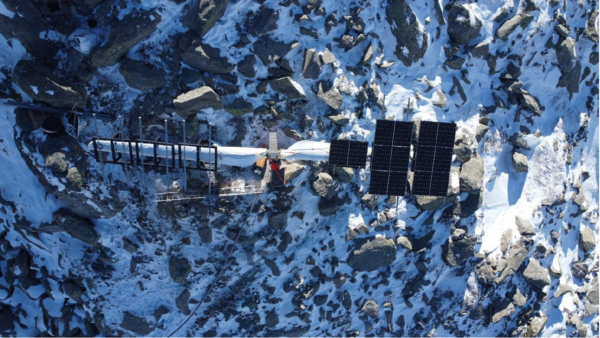Swiss startup Turn2Sun Renewables, a subsidiary of engineering consulting group Planair, has developed a PV mounting structure made of end-of-life wind turbines. The “Blade2Sun” solution uses reused blades to support a metal structure that supports bifacial PV modules, bypassing the need for a standard mounting structure with metallic beams.
“The number of modules which can be mounted on a single blade depends on various parameters, such as the blade length, the lateral reinforcement, and the local weather conditions, notably wind and snow,” Noé Tallon, project chief for Planair told pv magazine.
The company installed a prototype at a 2,500-meter altitude site in the Grisons region of Switzerland. It features nine bifacial 430 W solar modules on one blade and another seven panels on the other blade, in rows of three in landscape position.
“There are no lateral reinforcements, as the pilot only uses standard PV-mounting rails commercially available,” said Tallon. “The prototype’s next iterations will use reinforcements to reach a wider span and therefore increase the number of parallel modules on a single blade.”
The wind turbine blades in the pilot installation are 8.4 meters long and weigh 420 kg each. They are mounted on a 5-meter-high support structure. Tallon said that Turn2Sun aims to install the solar mounting structure as close as possible to repowered wind parks, in order to minimize transportation costs and the total carbon footprint.
“The main cost advantage of this solution is the use of used wind turbine blades which have a raw cost negligible or even negative, making it very competitive compared to heavy metal structures usually used for elevated PV installations and making for a significant fraction of the global costs,” claimed Tallon.
The company said it is developing partnerships with several global players to offer the Blade2Sun solution in countries other than Switzerland. The applications reportedly include carparks, water reservoirs, agrivoltaics installations, and roadside arrays.

Image: Turn2Sun
This content is protected by copyright and may not be reused. If you want to cooperate with us and would like to reuse some of our content, please contact: editors@pv-magazine.com.



2 comments
By submitting this form you agree to pv magazine using your data for the purposes of publishing your comment.
Your personal data will only be disclosed or otherwise transmitted to third parties for the purposes of spam filtering or if this is necessary for technical maintenance of the website. Any other transfer to third parties will not take place unless this is justified on the basis of applicable data protection regulations or if pv magazine is legally obliged to do so.
You may revoke this consent at any time with effect for the future, in which case your personal data will be deleted immediately. Otherwise, your data will be deleted if pv magazine has processed your request or the purpose of data storage is fulfilled.
Further information on data privacy can be found in our Data Protection Policy.